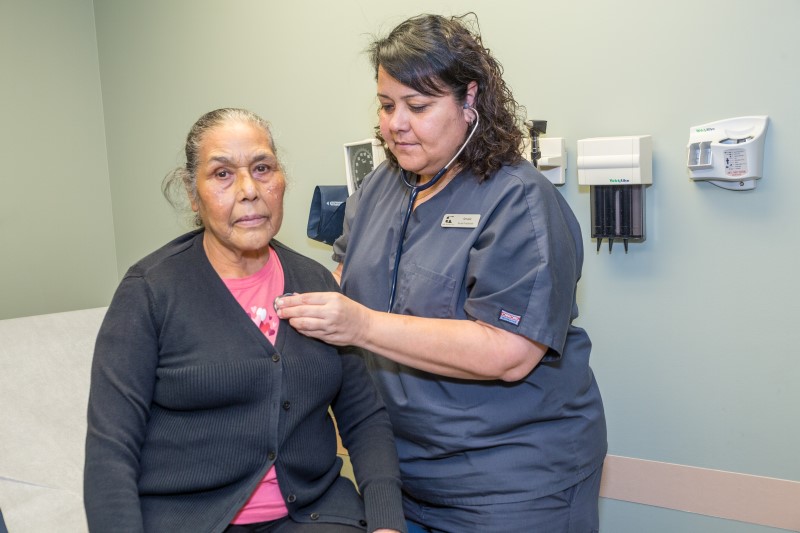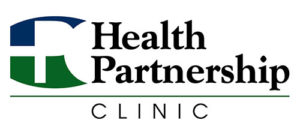Health Partnership Clinic Goes Red
 Post written by Amalia Almedia, APRN
Post written by Amalia Almedia, APRN
Board-certified nurse practitioner, specializing in women’s health
Chief of Clinical Services and Quality
Kicks off American Heart Month with National Wear Red Day
On Friday, Feb. 2, 2018 staff at Health Partnership Clinic will be wearing red to help the American Heart Association (AHA) and Go Red For Women celebrate American Heart Month and raise heart disease awareness by participating in National Wear Red Day.
Why Go Red? Cardiovascular disease in the U.S. kill approximately one woman every 80 seconds. The good news is that 80 percent of cardiac events may be prevented with education and lifestyle changes.
At HPC, we have the expertise to help women understand and manage their heart disease risk factors as part of the preventive and primary care services we provide to patients. Heart disease is the number one cause of death among women and few women are aware of their personal risk factors. The disease is disproportionately prevalent among Black and Latina women who report a higher incident of six manageable risk factors including:
- High blood cholesterol
- High blood pressure
- Tobacco smoke
- Physical inactivity
- Obesity or overweight
- Diabetes
Ms. Almeida recommends individuals learn how to control their risk for heart disease by talking to their primary doctor and becoming more informed. The AHA’s Take Action with Life’s Simple 7 is a great start to a healthier heart.
- Get active
Daily physical activity increases your length and quality of life. If you get at least 30 minutes of moderate physical activity each day (like brisk walking), five times per week, you can almost guarantee yourself a healthier and more satisfying life while lowering your risks for heart disease, stroke and diabetes.
What To Do
Start by learning the basics about fitness. Also, children need 60 minutes a day–every day–of physical activity, so find ways to workout with your kids to help ensure their heart health in addition to your own.
- Control cholesterol
 When you control your cholesterol, you are giving your arteries their best chance to remain clear of blockages.
When you control your cholesterol, you are giving your arteries their best chance to remain clear of blockages.
Cholesterol is a waxy substance and our bodies use it to make cell membranes and some hormones, but when you have too much bad cholesterol (LDL), it combines with white blood cells and forms plaque in your veins and arteries. These blockages lead to heart disease and stroke.
What To Do
Healthy eating requires planning, but a little bit of thought goes a long way toward a better life. The AHA recommends that you eat a wide variety of nutritious foods daily from each of the basic food groups.
To get the nutrients you need, choose foods like vegetables, fruits, fiber-rich whole-grain breads and cereals and fat-free or low-fat dairy products most often.
Foods that can help lower cholesterol:
- A variety of whole- and multi-grain products, such as bran and oats
- Fatty fishes, such as salmon, mackerel and albacore tuna
- Foods rich in antioxidants, such as fruits and vegetables
- Foods high in omega-3 fatty acids, such as avocado, flax seeds, olive oil and canola oil
- Foods rich in plant sterols, such as nuts like walnuts and almonds
The American Heart Association lists these foods to avoid (or consume in moderation):
Foods to avoid (or consume in moderation):
- Animal products high in saturated fat (beef, lamb, veal, pork, duck, goose, cream, cheese, butter, egg yolk)
- Fried foods
- High-fat processed meats, such as hot dogs and sausages
- Simple sugars (found in soft drinks, candy, cakes, cookies and other baked goods)
- Saturated oils, such as coconut and palm oil
- Shortening, partially hydrogenated margarine and lard
- Eat better
Healthy foods are the fuel our bodies use to make new cells and create the energy we need to thrive and fight diseases. If you are frequently skipping out on veggies, fruit, low-fat dairy, fiber-rich whole grains, and lean meats including fish, your body is missing the basic building blocks for a healthy life.
What To Do
Want more ways to eat better? Try these tips:
- Track what you eat with a food diary
- Eat vegetables and fruits
- Eat unrefined fiber-rich whole-grain foods
- Eat fish twice a week
- Cut back on added sugars and saturated fats
- Manage blood pressure
High blood pressure is a major risk factor for heart disease and stroke. When your blood pressure stays within healthy ranges, you reduce the strain on your heart, arteries, and kidneys which keeps you healthier longer.
High blood pressure, also known as hypertension, means the blood running through your arteries flows with too much force and puts pressure on your arteries, stretching them past their healthy limit and causing microscopic tears. Our body then kicks into injury-healing mode to repair these tears with scar tissue. But unfortunately, the scar tissue traps plaque and white blood cells which can form into blockages, blood clots, and hardened, weakened arteries.
What To Do
To manage blood pressure, you should:
- Eat a heart-healthy diet, which includes reducing sodium
- Get regular physical activity and maintain a healthy weight
- Manage stress, limit alcohol and avoid tobacco smoke.
- Lose weight
If you have too much fat — especially if a lot of it is at your waist — you’re at higher risk for such health problems as high blood pressure, high blood cholesterol and diabetes. If you’re overweight or obese, you can reduce your risk for heart disease by successfully losing weight and keeping it off. Even losing as few as five or ten pounds can produce a dramatic blood pressure reduction.
What To Do
Calculate your body mass index (BMI) to help you determine if you need to lose weight.
- Reduce blood sugar
Most of the food we eat is turned into glucose (or blood sugar) that our bodies use for energy. Your body makes a hormone called insulin that acts like a carrier to take your food energy into your cells. If your fasting blood sugar level is below 100, you are in the healthy range. If not, your results could indicate diabetes or pre-diabetes.
Although diabetes is treatable and you can live a healthy life with this condition, even when glucose levels are under control it greatly increases the risk of heart disease and stroke. In fact, most people with diabetes die from some form of heart or blood vessel disease.
What To Do
The following tips can all help reduce your blood sugar:
- Reduce consumption of simple sugars that are found in soda, candy and sugary desserts
- Get regular physical activity! Moderate intensity aerobic physical activity directly helps your body respond to insulin
- Take medications or insulin if it is prescribed for you
- Stop smoking
Cigarette smokers have a higher risk of developing cardiovascular disease. If you smoke, quitting is the best thing you can do for your health. Smoking damages your entire circulatory system, and increases your risk for coronary heart disease, hardened arteries, aneurysm and blood clots. Like a line of tumbling dominoes, one risk creates another. Blood clots and hardened arteries increase your risks for heart attack, stroke and peripheral artery disease. Smoking can also reduce your good cholesterol (HDL) and your lung capacity, making it harder to get the physical activity you need for better health.
What To Do
Whatever it takes for you to stop smoking, it is worth it!
- Visit the AHA’s Quit Smoking website for tools and resources.
- Learn more about “Life’s Simple 7” and take action with AHA’s MyLifeCheck.
As with other chronic diseases, heart disease requires lifelong management. Making heart healthy changes in your daily life remains the single most effective way to prevent heart diseasee.
About Amalia Almeida, APRN:
Ms. Almeida has been practicing as a nurse since 1999 and as a nurse practitioner since 2007. She specializes in women’s health, including colposcopy. She cares for women of all ages at our Olathe Clinic and serves as Chief of Clinical Services and Quality.






